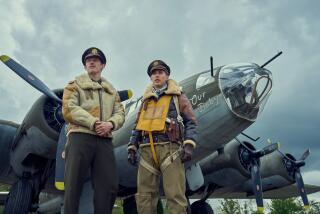A Navigator’s Final Pass in a B-17G
- Share via
When I first climbed into this glorious old airplane, she was diminished, more wreck than relic of epic aerial warfare.
What had been built for the Air Force in 1944 as a B-17G Flying Fortress had been demoted by 1976 to fighting California forest fires. Stinking layers of maroon slurry stained her undersides. What cockpit instruments worked were best read as estimates. Turrets, seats, radios, guns, bombsight, crew stations . . . cut away, gone.
Yet this shell still flew with forgiveness and trust. So what that in rain, the cockpit became a car wash? Loyalty and indestructibility were intact; her soul and history ready for restoration.
Four of us began the work. Then 15. Then 50 loving amateurs that formed around the airplane as the Arizona Wing of the Confederate Air Force, a group dedicated to the preservation of World War II aircraft.
The old bomber was steam-cleaned and water-blasted. We buffed her to bright aluminum by hand, by the hectare. Weekend by month by year, her engines, controls, avionics, landing gear, wiring and panel were rebuilt. Boneyards, junk yards, veterans’ souvenirs, abandoned museums, even crashed bombers uncovered by a Zuider Zee reclamation, gave us . . . those turrets, seats, radios, guns, bombsights and crew stations.
She was returned to the insignia of the 8th Air Force. Then we held a contest to name the airplane. A wife suggested the title of a song, the one she and her bombardier husband had danced to in 1944. “Sentimental Journey.”
So we painted that and Betty Grable on her nose and went barnstorming from Harlingen, Tex., to Oshkosh, Wis.
The last time I climbed into this glorious airplane was Wednesday. We flew from Ontario and were given permission to make a booming pass that spiced the afternoon at Burbank Airport before landing at Van Nuys.
That’s where she’ll be today and Sunday. She’s parked with her blue-striped tail almost overhanging Sherman Way. Entrance is through Best Western Airtel Plaza, 7277 Valjean.
For $3, from 8:30 a.m., a CAF colonel will take you through the airplane. If you can feel, you will be in a time machine.
And in that, at peace, the mission of “Sentimental Journey” has clearly transcended its function at war.
Former B-17 pilots and navigators have wept at the sight of this airplane that brought them back from Schweinfurt and Ploesti. A very aged mother once asked to see the radio compartment. There she prayed for the son who had written home about his cubicle, then was killed there.
Mostly, I think about Bob Millhouse.
He was 59 and dying from Lou Gehrig’s disease and he had locked up what was left of his life. A will had been written, assets assigned. Millhouse had even chosen a favorite place for his last season: winter in Arizona.
That’s where he heard familiar thunder. He looked up. “Sentimental Journey” was overhead and landing near Phoenix, and Millhouse began remembering. . . .
1944 and Attleborough, England. Millhouse was a B-17 navigator with the 452nd Bomb Group. He had survived 37 missions over Germany.
That punched a hole in all the somber neatness. He drove to find “Sentimental Journey.” He said he wanted one last look, one last touch as a final bonus.
Her sentimental travelers went one better. We carried Millhouse into the nose, sat him at the navigator’s table, fired up the airplane and took off.
Millhouse said he could see and hear everything again. Big Bill Mackenzie, his old skipper. Quick shadows of German fighters on firing passes. Shrieks on the intercom: “Bandits, 3 o’clock high and engaging . . . nine minutes to target. . . . “
And when the flight was done, Millhouse said: “I felt an elation I can’t quite understand. I guess it’s reconnecting with youth. It’s remembering the real men I knew during the war.
“The flight has rounded it all out. I’ll be forever grateful.”
His forever lasted only three months.
More to Read
Sign up for Essential California
The most important California stories and recommendations in your inbox every morning.
You may occasionally receive promotional content from the Los Angeles Times.













